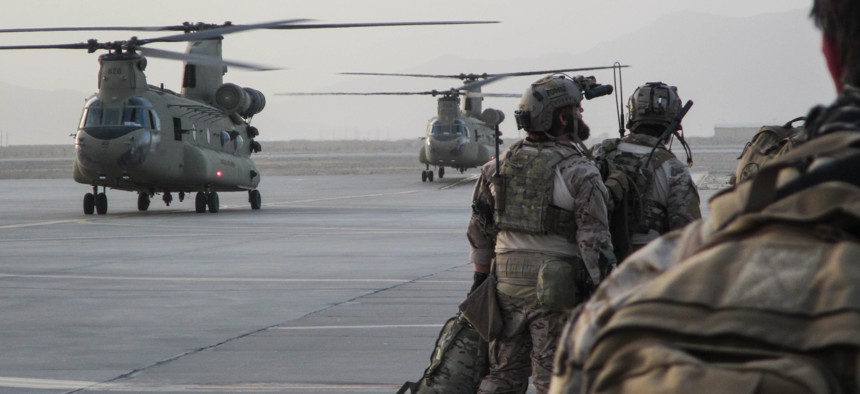
U.S. Special Forces soldiers and agents from Afghanistan's National Interdiction Unit prepare to load onto CH-47 Chinook helicopters for an operation in Helmand province on Sept. 12, 2016. U.S. Army / Sgt. Connor Mendez
Special Operations Seeks 20% R&D Budget Bump
Collaborative autonomy and better contested communications top the wish list, while supply-chain risk becomes a top concern.
A 20 percent bump to its research-and-development budget would help U.S. Special Operations Command foster autonomous drones, battlefield comms, and other gear and weapons to help pivot from counterterrorism to great-power competition, the command’s chief acquisitions executive said. SOCOM is also grappling with new attacks on supply chains and networks, James Smith told reporters last week.
SOCOM is asking for an increase of about one-fifth from last year’s request of $696 million. The proposed uptick is an about-face for the command; last year, it requested 14 percent less for R&D than the $813 million it received in 2021.
Smith said this year’s increased ask reflects an understanding of the growing role for autonomous drones and other unmanned systems working with operators in high-stakes operations.
SOCOM’s commander, Gen. Brian Fenton, “has really focused on collaborative autonomy,” Smith said. “So he wants to lead the department in terms of how we have a systems-of-systems approach to unmanned aerial systems, being able to interoperate not only with each other in a collaborative fashion but also with with ground systems and maritime systems, all unmanned, to be able to have effects at the edge.”
For example, SOCOM’s Adaptive Airborne Enterprise project seeks to allow a single operator to direct a swarm of Reaper drones. It’s pioneering work that—like other weapons and gear speedily developed in small batches by the relatively small command—may eventually find its way into use by other commands and service branches.
That structure enabled SOCOM to speed new pieces of equipment to field faster in the Middle East, against adversaries that were dangerous and difficult to detect but didn’t have highly advanced technology. But in the competition with China and Russia, the command must also ensure that their new tech isn’t compromised by enemy parts or software.
“Everyone knows about the microchip issue,” Smith said. “But it's more about are there malign actors in our supply chain? Are there malign dollars? Malign leadership, etc. in our supply chain, and what do we do about that? How well do our industry partners understand the rest of their cybersecurity backbone? Because, you know, protecting their information on their internet is really important to us.”
Smith spoke ahead of Global SOF’s “Sofweek” conference in Tampa next month. The conference is expected to attract participants from around the world and more vendors than ever, organizers told reporters.




